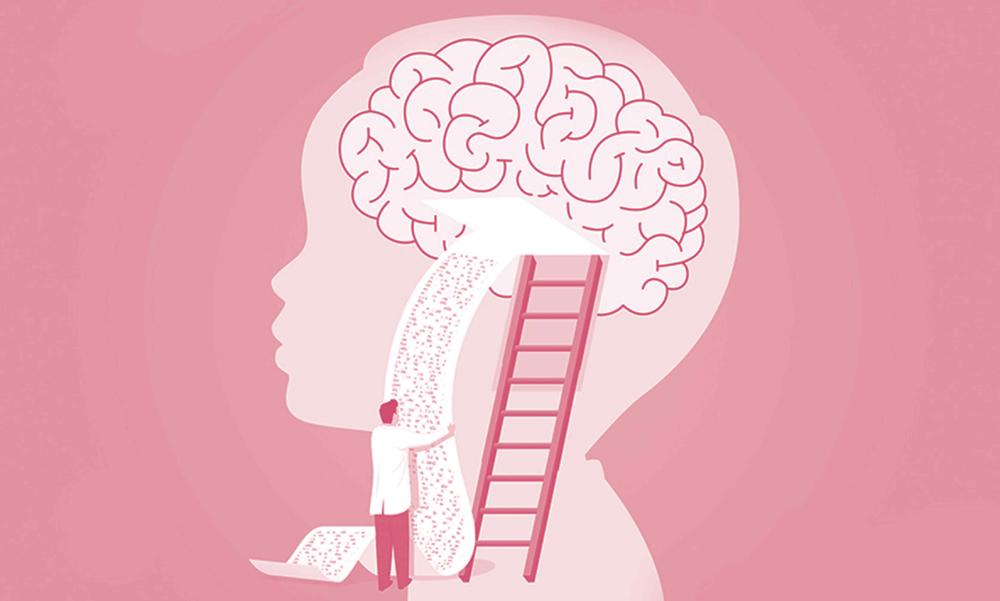Why Are Teenagers So Vulnerable to Mental Illness?为何青少年易患精神疾病
约翰·埃尔德/文 李婧萍/译

Cambridge scientists have found that the adolescent brain undergoes a “disruptive” form of remodelling—during which new networks come online—allowing teenagers to develop more complex adult social skills.
But this disruptive phase, which sees a somewhat radical shift in the strengthening and weakening of certain neural connections, may explain why young people have an increased risk of mental illness.
This discovery was part of a big-picture finding that the functional connectivity of the human brain—how different regions of the brain communicate with each other—changes in two main ways during adolescence.
According to a statement from Cambridge, the study collected functional magnetic resonance imaging (fMRI) data on brain activity from 298 healthy young people, aged 14 to 25 years, each scanned on one to three occasions about six to 12 months apart.
As the participants were bid to lie still and as quietly as possible, the researchers analysed the pattern of connections between different brain regions while the brain was in a resting state.
Please dont move, dont talk
Measuring functional connectivity in the brain presented particular challenges, said Dr Franti?ek Vá?a, who led the study.
“Studying brain functional connectivity with fMRI is tricky as even the slightest head movement can corrupt the data—this is especially problematic when studying adolescent development as younger people find it harder to keep still during the scan,” said Dr Vasa, in a prepared statement.
“Here, we used three different approaches for removing signatures of head movement from the data, and obtained consistent results, which made us confident that our conclusions are not related to head movement, but to developmental changes in the adolescent brain.”
What the scientists found
The scans revealed that “the brain regions that are important for vision, movement, and other basic faculties were strongly connected at the age of 14 and became even more strongly connected by the age of 25”.
The scientists called this a “conservative” pattern of change, as areas of the brain that were rich in connections at the start of adolescence become even richer during the transition to adulthood.
In other words, the changes were of a consolidating character—and perhaps not so surprising.
However, the scans showed “the brain regions that are important for more advanced social skills, such as being able to imagine how someone else is thinking or feeling (so-called theory of mind), underwent a more ‘disruptive pattern of change”.
In these regions—mainly in whats known as the association cortex—connections were redistributed over the course of adolescence: Connections that were initially weak became stronger, and connections that were initially strong became weaker.
By comparing the fMRI results to other data on the brain, the researchers found the network of regions that showed the disruptive pattern of change during adolescence had high levels of metabolic activity typically associated with active remodelling of connections between nerve cells.
The mystery of adolescent mental illness
Professor Ed Bullmore, joint senior author of the paper and head of the Department of Psychiatry at Cambridge, said: “We know that depression, anxiety and other mental health disorders often occur for the first time in adolescence—but we dont know why”.
“These results show us that active remodelling of brain networks is ongoing during the teenage years and deeper understanding of brain development could lead to deeper understanding of the causes of mental illness in young people.”
The new study appears to build on a 2016 Cambridge experiment that used magnetic resonance imaging (MRI) to study the brain structure of almost 300 individuals aged 14 to 24 years old.
By comparing the brain structure of teenagers of different ages, they found that during adolescence, the outer regions of the brain, the cortex, shrink in size, becoming thinner.
However as this happens, levels of myelin—the sheath that insulates nerve fibres, allowing them to communicate efficiently—increase within the cortex.
According to a statement from the university, myelin was thought mainly to reside in the so-called “white matter”, the brain tissue that connects areas of the brain and allows for information to be communicated between brain regions.
However, the researchers show that it can also be found within the cortex, the “grey matter” of the brain, and that levels increase during teenage years.
In particular, the myelin increase occurs in the association cortical areas—the areas of the brain shown to undergo disruptive changes in the more recent study.
These are regions of the brain that act as hubs, the major connection points between different regions of the brain network.
The researchers compared their MRI results with Allen Brain Atlas, which maps regions of the brain by gene expression—the genes that are switched on in particular regions.
They found that “those brain regions that exhibited the greatest MRI changes during the teenage years were those in which genes linked to schizophrenia risk were most strongly expressed”.
剑桥大学的科学家们发现,青少年的大脑会经历一种“破坏性”重塑——在此期间,新的神经网络出现——使青少年发展出更复杂的成人社交技能。
但这个破坏性阶段或许能够解释为什么年轻人患上精神疾病的风险会加大。在这一阶段,某些神经连接增强和减弱时的变化有些剧烈。
这项发现是一个宏观研究结果的一部分,该研究发现:人类大脑的功能连接(大脑不同区域之间的相互交流)在青春期主要以两种方式发生变化。
剑桥大学的报告称,这项研究共收集了298名受试者大脑活动的功能磁共振成像数据,他们身体健康,年龄处于14到25岁之间,各扫描1到3次,每次间隔6到12个月。
受试者按要求尽量安静平躺且保持不动,研究人员在其大脑处于休息状态时分析不同脑区的连接模式。
请勿动勿言
测量大脑的功能连接颇具挑战性,领导这项研究的弗朗齐歇克·瓦沙博士如是说。
瓦沙博士在一份预先准备好的声明中提到:“用功能磁共振成像技术研究大脑的功能连接并不太好把握,因为即使是最轻微的头部运动也会破坏数据——而这在研究青春期发育时尤其棘手,毕竟年龄越小越难在扫描过程中保持不动。
“研究中,我们分别用了三种不同的方法从数据中剔除头部运动产生的影响,三种方法得到的结果一致,因此我们确信最终的结论与头部运动无关,而与青少年大脑的发育变化有关。”
科学家们的发现
扫描结果显示,“14岁时,大脑中关乎视觉、运动和其他基本能力的重要区域彼此紧密关联,到25岁这种关联变得更加紧密”。
科学家们称此为“保守的”变化模式,因为早在青春期初期就有紧密连接的大脑区域,只不过在向成年过渡的过程中变得连接更加紧密。
换言之,这些变化具有的是增强巩固的性质,或许并没有那么新奇。
然而,扫描结果显示,“大脑中那些牵涉高级社交技能——比如能够想象他人想法或感受(所谓的心理推测能力)——的重要区域,经历了相对更具‘破坏性 的变化。”
在这些区域(主要是所谓的联络皮质)中,各种连接在整个青少年时期被重新分配:最初较弱的连接变强,而最初较强的连接变弱。
通过比较功能磁共振成像结果与其他大脑数据,研究人员发现,青春期呈现破坏性变化模式的大脑区域网络代谢活动旺盛,这通常与神经细胞之间连接发生活跃的重构息息相关。
探秘青春期精神疾病
该论文资深的共同作者、剑桥大学精神病学系主任埃德·布尔莫教授说:“我们知道,抑郁、焦虑和其他精神健康障碍首次出现常常是在青春期,但我们不了解原因。
“这些结果告诉我们,青少年时期大脑网络重构活跃,随着对大脑发育的深入了解,我们有可能进一步了解年轻人罹患精神疾病的种种诱因。”
这项新研究似是基于2016年剑桥大学的一项实验进行的,该实验使用磁共振成像研究了近300名14岁至24岁受试者的大脑结构。
他们通过对比不同年龄青少年的大脑结构发现:在青春期,大脑外部区域(即皮层)会缩小且变薄。
但与此同时,皮层内的髓鞘数量增加。髓鞘可隔离神经纤维,使其有效交流。
根据剑桥大学的报告,髓鞘被认为主要存在于所谓的“白质”中——“白质”是连接大脑各区域的组织,能让大脑各区域进行信息交流。
不过研究人员也证明,髓鞘可能还存在于大脑皮层(即大脑的“灰质”)中,而且其数量在青少年时期会有所增加。
尤其是,髓鞘的增加发生在联络皮质区域——近期这项研究显示,恰是這些区域发生了破坏性变化。
大脑的这些区域起到枢纽作用,是大脑网络不同区域之间的主要连接点。
研究人员将受试者的核磁共振成像结果与艾伦脑图谱进行了比较,艾伦脑图谱是通过基因表达(在特定区域被激活的基因)绘制出的大脑区域图。
他们发现,“青少年时期核磁共振变化最大的那些脑区,是与罹患精神分裂症相关的基因表达最强烈的那些区域”。
(译者单位:北京外国语大学)

